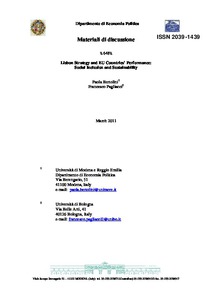Lisbon Strategy and EU countries' performance: social inclusion and sustainability
"In 2010, the Lisbon Strategy came to its end. Even if many targets have not been fully reached by each of the 27 EU Members, a new and more ambitious reform strategy has been launched: the Europe 2020 Strategy. In order to evaluate the results of the Lisbon Strategy and of Europe 2020 Strategy...
| Main Authors: | , |
|---|---|
| Institution: | ETUI-European Trade Union Institute |
| Format: | TEXT |
| Language: | Italian |
| Published: |
Modena
2011
University of Modena |
| Subjects: | |
| Online Access: | https://www.labourline.org/KENTIKA-19177886124919950689-Lisbon-Strategy-and-eu-countri.htm |
| Summary: | "In 2010, the Lisbon Strategy came to its end. Even if many targets have not been fully reached by each of the 27 EU Members, a new and more ambitious reform strategy has been launched: the Europe 2020 Strategy. In order to evaluate the results of the Lisbon Strategy and of Europe 2020 Strategy, many indicators are yearly collected and published by EUROSTAT. From the analysis of these indicators, the work analyses how different European countries perform in economic, social and environmental issues. The paper moves from the works of Sapir [2006], who has already underlined –among the EU-15 – the existence of four different European social models (Nordic, Anglo-Saxon, Continental, Mediterranean), sharing different combinations of economic efficiency and social equity. This work tries to go further. First, it also underlines the role of the environmental issues in defining a sustainable European social model. Then, the analysis includes also Eastern countries, trying to identify the existence of possible Eastern social models. Therefore, in order to identify different European social models, we use a multivariate statistics methodology, i.e. the Principal Component Analysis (PCA), applied to a set of 20 variables (all the variables included in the short list of indicators from EU plus other environmental indicators) collected for all the European countries. The obtained results are among the expected ones. Sapir’s results are largely confirmed. In particular the supremacy of the Nordic model is straightforward. On the opposite side, when including environmental indicators, the Anglo-Saxon model seems to perform worse than Mediterranean one. Finally, referring to Eastern countries, a single social model does not emerge." |
|---|---|
| Physical Description: | 19 p. Digital |

